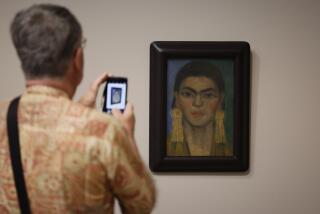Dorothea Lange’s iconic California image ‘Migrant Mother’ resonates in today’s social turmoil
- Share via
Dorothea Lange was driving by a pea pickers’ camp on the California coast when she stumbled across a weary mother and her many children huddled in a lean-to.
It was 1936, during the throes of the Great Depression, and Lange took out her camera.
The image she titled “Migrant Mother” became the late photographer’s most famous work, capturing the dirt and despair of that era through the eyes of a 32-year-old woman who had just sold her car tires for food.
The photograph, digitally scanned and enlarged, is a dominant feature of a new exhibit at the Oakland Museum of California called “Dorothea Lange: Politics of Seeing.” The exhibit of 100 of Lange’s photographs includes Dust Bowl migrants, Japanese Americans incarcerated during World War II, the homeless and postwar urban decline.
RELATED: The story of the photo
The show also features the work of three modern photographers — Ken Light, Janet Delaney and Jason Jaacks — who were influenced by Lange’s work.
Drew Johnson, who curated the show, said Lange’s focus on poverty is timely in an age of economic disparity. The forced relocation of Japanese Americans during WWII echoes today’s debate over proposed travel bans, he said, and her postwar work on changing cities precedes battles over gentrification in places like San Francisco and Oakland.
“We live in troubled times, as you know, and I think it is impossible not to visit the exhibit and make some connections to things happening today,” Johnson said. “It shows how a photographer can assume the role of activist to try to instigate social change.”
Lange, born in 1895 in Hoboken, N.J., ran a portrait studio in San Francisco in the 1920s before becoming a pioneer of documentary photography.
When the Great Depression hit, Lange had only to look outside the windows of her studio in downtown San Francisco for subjects. One of her earliest and most recognized works is “White Angel Breadline,” showing a lone man with a tin cup facing away from a San Francisco soup kitchen in 1933.
Her most famous photograph was of 32-year-old Florence Owens Thompson, a mother of seven, at a pea pickers’ camp in the town of Nipomo, Calif.
An exhausted Lange was driving from Southern California to her home in Berkeley when she stumbled upon the family. Thompson had just sold her tires so her family could eat. She was sitting in a tent with her children, a baby at her breast.
The Lange exhibit includes six other pictures made just before “Migrant Mother.”
The major themes of the Lange exhibit are the Great Depression, the home front during WWII and urban decline and postwar sprawl in California.
Lange was known as a photographer of great empathy, someone who spent time with her subjects and took meticulous notes of their lives for detailed photo captions.
Ken Light, a social documentary photographer and photojournalism professor at UC Berkeley, says if Lange was alive today, she would be documenting homeless tent cities, the U.S.-Mexico border and poverty in California’s Central Valley.
“Revisiting stories she did so well because these stories, they don’t disappear,” he said.
Documentary photographer Janet Delaney said Lange would be following the issue of homelessness, but her work may not have resonated in today’s world.
“I think we all have image fatigue,” Delaney said. “It’s a tough story to get out.”
The Oakland museum houses the largest collection of Lange’s work, including 25,000 negatives and 6,000 prints that it received as a gift 50 years ago from Lange’s husband, Paul S. Taylor. The exhibit coincides with the 50th anniversary of her death and the gifting of the archive.
Lange lived most of her life in liberal Berkeley. She battled the effects of polio, which she contracted at age 7, for the last two decades of her life and died of esophageal cancer in 1965.
Visitors have a chance to hear from Lange herself, in segments of a 2014 documentary by Lange’s granddaughter Dyanna Taylor.
“In every direction that you look, the camera is a powerful instrument by saying to the world, ‘This is the way it is. Look at it, look at it!’” she said.
The exhibit runs through Aug. 13.
More to Read
Sign up for Essential California
The most important California stories and recommendations in your inbox every morning.
You may occasionally receive promotional content from the Los Angeles Times.










